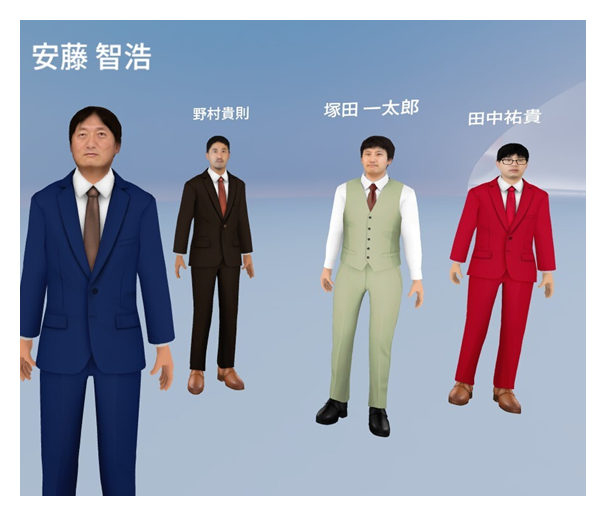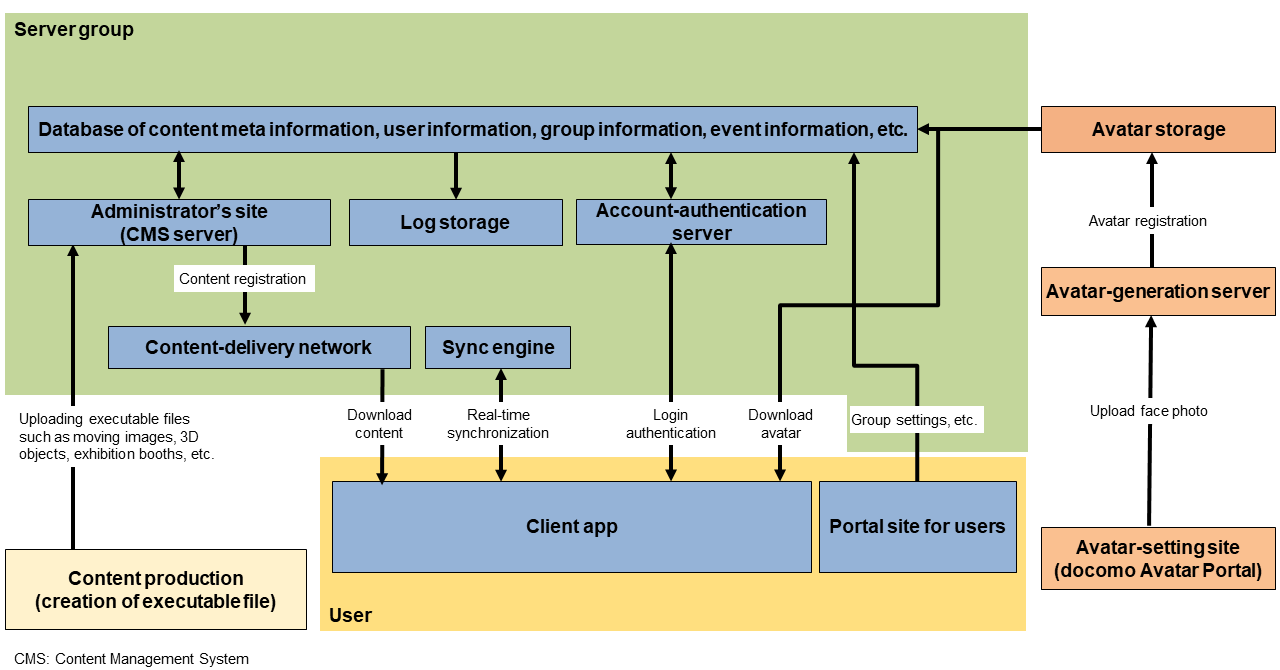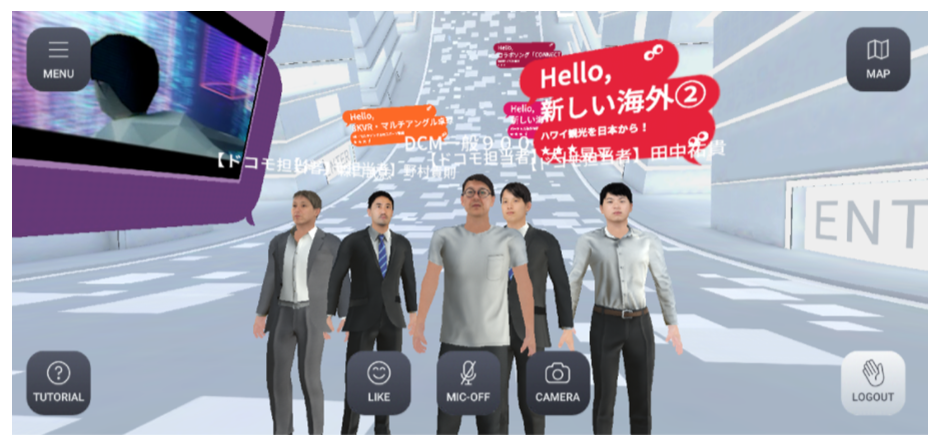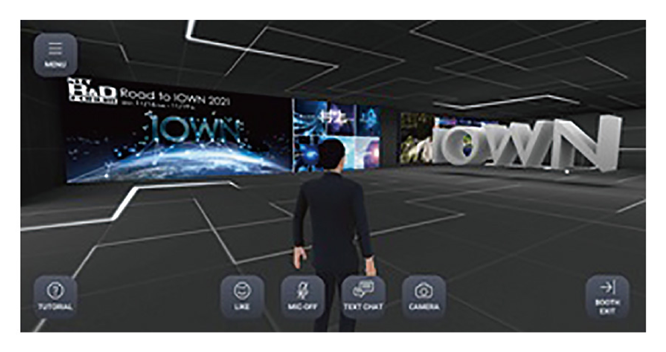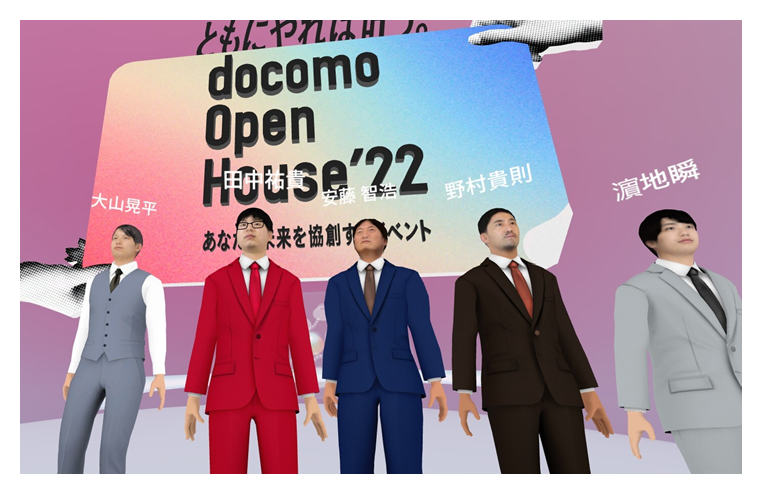Special Articles on XR—Initiatives to Form an XR Ecosystem—
Platform for Enabling Users to Participate in Events “Anytime, Anywhere”
VR Virtual Event Platform
Yuki Tanaka†1, Takanori Nomura†2 and Keiichi Murakami†1
Communication Device Development Department
†1 Currently, NTT QONOQ, INC.
†2 Currently, Product Department
Abstract
In recent years, the need for online events has been growing as companies, individuals, and organizations who hold events have been aiming to reach a global audience and the COVID-19 pandemic has made it difficult to hold real events. Given those circumstances, NTT DOCOMO has developed a platform that supports multiple devices and enables users to participate in online events “anytime, anywhere.” In this article, the background to the development of the platform and its features are described, and examples of actual applications of the platform are presented.
01. Introduction
-
In recent years, the need for online events has been ...
Open

In recent years, the need for online events has been growing as companies, individuals, and organizations who hold events have been aiming to reach a global audience, and the COVID-19 pandemic has made it difficult to hold real events. Online events are held in various forms: some events can simply be experienced with a Web browser and other more-sophisticated virtual events require Virtual Reality (VR)*1 applications.
A recent survey revealed that about 80% of events had shifted from real events to online events in 2020 [1]. Online events also have the advantage of being able to respond to global demand, and it is expected that online events will continue to be widely held in the future. Under these circumstances, NTT DOCOMO has developed a platform that is compatible with multiple devices and enables users to participate in online events “anytime, anywhere.”
The platform enables users to participate in events as avatars generated from their face photos and communicate with other users and attendants in a virtual 3-Dmensional (3D) space, and incorporates unique technologies such as 8KVR, volumetric video*2, and motion capture to enhance the value of the online-event experience. In this article, the background to the development of the platform and its features are described, and some examples of actual applications of the platform are presented.
- VR: Virtual reality.
- Volumetric video: 3D moving-image data of a person or object—consisting of shape data and surface-texture data of the object.
-
Although many online events have been held recently owing to ...
Open

Although many online events have been held recently owing to the impact of the COVID-19 pandemic, online events can be categorized according to the following two major issues.
1) Losing the Advantage of Real Events
Since online events offer mainly virtual experiences, it may be difficult for participants to deepen understanding of exhibits and feel the sense of presence compared to experiences at real event venues.
2) Incurring Costs of Creating and Operating Virtual Events
Online events that specialize in virtual experiences incur significant operating costs. For example, developing a dedicated application (hereinafter referred to as “app”) for each event, creating virtual floor space and exhibition booths, and operating servers after the release of the app all make the cost of implementing a single event very high. To address these issues, NTT DOCOMO has developed a platform that enables users to experience online events in a virtual 3D space.
-
3.1 Addressing the Issues
Open

1) Issue: Losing the Advantage of Real Events
The platform uses a virtual 3D space to create 3D representations of exhibits and people in a manner that gives participants experiences that are similar to those of real events with the added value of virtuality. NTT DOCOMO has studied the basic functions for crating virtual-event experiences and the implementation of proprietary technologies.
(a) Basic functions for creating virtual-event experiences
The platform is composed of a floor space containing individual exhibition booths, and users can walk around those spaces and have various experiences while operating their own avatars (Figure 1). The floor space replaces the route map at a real event venue in a manner that allows users to enter exhibition booths of their own interest from among the various exhibition booths arranged in the floor space.
This platform is equipped with a group function that allows users to form groups with their on-line acquaintances, enter the event with multiple people, and walk around the venue together. The groups can communicate through voice calls, text chats, and the operation of the avatars. Moreover, the platform supports multiple devices, namely, smartphones and tablets (Android/iOS), PCs (Windows/Mac), and Meta Quest2*3 VR headsets.
(b) Unique features that add value
(1) Linkage with docomo Avatar Portal [2]
As described above, when participating in the event, users can form groups and go around the booths as a group; however, to enhance the sense of realism, the platform is linked to the docomo Avatar Portal, which allows users to select their own original avatar generated from their face photo. Users can then enter the event venue as that avatar, which allows them to enjoy the event in a more realistic manner when touring the event venue with their acquaintances (Figure 2).
(2) 8KVR
8KVR is a technology that enables viewing of real-time streaming of 360-degree VR video. It allows users to experience VR images with a sense of presence—as if they were there—even if they are in a remote location [3]. For example, images of tourist attractions are recorded with dedicated equipment and streamed in a way that enables users to experience 360-degree local images in high-resolution VR (Figure 3 (a)).
(3) Volumetric video
Volumetric video is a technology that allows users to view objects videoed from multiple angles as 3D objects in an exhibition booth. Volumetric video shot with NTT XR Studio [4][5] and other video equipment can be experienced on this platform. For example, by changing the viewpoint to the desired angle or moving closer to a position that would normally be impossible, users can watch a live music or sports event with a more immersive experience than the real experience (Fig.3 (b)).
(4) Motion capture
Motion capture is a technology that reproduces the movement of people or objects recorded as motion data by a motion-capture system onto 3D avatars in an exhibition booth and moves them in real time on the basis of that data. The user can view the avatars from any viewpoint in a manner that enables a highly immersive experience [6] (Fig.3 (c)). The technology can be utilized for creating a 3D avatar show with actors such as animation characters in a way that allows users to enjoy a unique experience that only a virtual system can provide.
(5) AI avatar
Although it is possible to have an attendant at an exhibition booth, it is difficult to have an attendant at all the exhibition booths over a long period of time because it requires a real person to operate each booth. Accordingly, for this platform, we used the docomo AI Agent API® [7] to develop Artificial Intelligence (AI) avatars and placed them as “AI attendants” in the unmanned booths. In this way, users can receive explanations of the exhibits at each booth from the AI avatar in virtual space. When users enter an exhibition booth, they are introduced to the booth by the AI avatar, which responds to the users’ questions automatically according to a pre-defined scenario.
2) Issue: Incurring Costs of Creating and Operating Virtual Events
This platform was developed to provide a mechanism for building and operating events at low cost.
(a) A system that allows event spaces to be constructed freely
The platform provides a development kit (by Unity*4) that event creators can use to freely construct a virtual space. Two objects can be created: floor space and exhibition booths.
(1) Floor space
In addition to the freedom to create individual shapes, it is also possible to create maps and set background music. Event creators can thereby express different themes for each event as if they were building a small city.
(2) Exhibition booth
In addition to create a 3D space, 2D video, background music, and volumetric video can be incorporated. The size of the booth space can also be set freely in a manner that makes it possible to exhibit huge objects in the virtual space. In turn, it becomes possible to exhibit different themes in different booths.
(b) Mechanism to make event management easier
The platform provides a Web site for administrators to make event management easier. This administrator’s site has the following functions for holding multiple events, settings related to 3D space such as floor space and exhibition booths, settings related to event operations such as the holding period, and data analysis.
(1) Function for holding multiple events
The administrator’s site is equipped with a function for holding multiple events simultaneously. Customized floor spaces and exhibition booths can be registered for each event and managed individually.
(2) Setting floor space
A bulletin board can be set up in a way that allows the event operator to send out information that it wants to make known in a timely manner.
(3) Setting exhibition booth
Videos and still images can be posted through the administrator’s site without the need for development using the real-time development platform Unity. Attendants can also be assigned from the administrator’s site, and the number of attendants can be set according to the booths.
(4) Setting the period of the event
The floor space and exhibition booths can be set up for a set period of time. Outside of the set period, users cannot enter the spaces, and content can be maintained during those periods.
(5) Data analysis
After an event is held, it is possible to obtain data such as number of participants (total number of participants and number of unique users), exhibition-booth data (number of visitors, time spent in the booth, and evaluation of exhibition booth), and results of evaluation questionnaire. These data are anonymous data about user behavior within the event and can be used for analyzing event trends. For example, by using that data to analyze popular spaces and content, it is possible to improve aspects of the event before the next event to be held.
The above-described mechanism and functions for making event management easier eliminate the need for hard coding*5 of individual events; consequently, events can be operated smoothly, and event-operation costs can be reduced.
3.2 Configuration of System
The system configuration for implementing the above-described functions is shown in Figure 4. The platform consists of client applications and servers, and it provides a Web site for administrators (as described above) and a portal site for users. Event creators can use Unity to create each exhibition booth, create shapes and content freely, and upload the executable files (content registration) from the administrator’s site to stream the latest content to client applications. The avatars, voices, and text-chat functions are implemented by using a synchronization engine, and a content-delivery network*6 was constructed for efficiently distributing content. This configuration enables the platform to hold multiple events simultaneously on a single client application.
- Meta Quest2: VR headset provided by Meta Platforms, Inc.
- Unity: A game engine provided by Unity Technologies.
- Hard coding: An implementation of source code that assumes a specific operating environment.
- Content delivery network: A network for high-speed, large-scale distribution of content.
-
Some examples of how this platform has been applied are ...
Open

Some examples of how this platform has been applied are presented as follows.
1) docomo Open House 2021
For four days from February 4 to 7, 2021, DOCOMO conducted a virtual exhibition, Open House 2021, based on this platform (Figure 5) [8]. At this event, more than a dozen exhibition booths, including content using “8KVR and volumetric video, could be prepared and exhibited in a relatively short period of time. Among them, the exhibition booth using volumetric video received a strong response from users, which indicates that there is a significant demand for such content.
2) NTT Communications Digital Forum
This event—NTT Communications Digital Forum—was held by NTT Communications over three days from October 20 to 22, 2021 [9]. One of the features of this event was a strong emphasis on the placement of attendants, and users were able to enjoy the event more by interacting with the attendants after viewing the seminar videos at each exhibition booth. A text chatbot*7, which can respond to questions even in the absence of an attendant, was also provided (Figure 6).
3) NTT R&D FORUM — Road to IOWN 2021
At NTT R&D FORUM — Road to IOWN 2021, held for four days from November 16 to 19, 2021, NTT used the platform for one of their exhibits at the event (Figure 7) [10]. At this event, booths exhibited content using volumetric video and a viewing experience using 8KVR.
4) docomo Open House’22
At docomo Open House’22, held over three days from January 17 to 19, 2022, NTT DOCOMO held a virtual exhibition using this platform (Figure 8) [11]. A unique feature of this event was NTT DOCOMO’s first exhibit utilizing motion-capture technology—which received a particularly strong response from many users.
- Chatbot: A program that automatically converses with people via voice or text.
-
A platform that is compatible with multiple devices and ...
Open

A platform that is compatible with multiple devices and enables users to participate in online events “anytime, anywhere” was described. In particular, the background leading to the development of the platform was explained, the features of the developed platform were described, and examples of application of the platform were presented. This platform supports features that are considered necessary for holding multiple events, enabling users to experience content unique to VR, and creating virtual events. Since the floor space and exhibition booths can be freely constructed, the platform can be used for purposes other than events, such as the metaverse. From now onwards, we will continue to study ways to make the platform a better experience by improving it according to user feedback from past events and incorporating elements that make events more exciting and develop it as a solution for corporate customers.
-
REFERENCES
Open

- [1] Peatix Japan K.K.: “2021 Peatix Event Survey Report,” Nov. 2021 (in Japanese).
 https://documents.peatix.com/2021_Peatix_Event_Survey.pdf
https://documents.peatix.com/2021_Peatix_Event_Survey.pdf - [2] NTT DOCOMO Press Release: “Development of ‘docomo Avatar Portal’ for creating and managing customers’ avatars in XR space,” Jan. 2022 (in Japanese).
https://www.docomo.ne.jp/info/news_release/2022/01/11_00.html - [3] NTT DOCOMO: “High-definition Video Transmission Solution NTT XR Live EX 8K” (in Japanese).
https://www.docomo.ne.jp/biz/service/le8kvr/ - [4] NTT DOCOMO: “docomo XR Studio, a photography studio dedicated to XR, opened in Odaiba,” Jan. 2021 (in Japanese).
 https://www.docomo.ne.jp/binary/pdf/info/news_release/topics_210114_00.pdf (PDF format:0)
https://www.docomo.ne.jp/binary/pdf/info/news_release/topics_210114_00.pdf (PDF format:0) - [5] M. Abe, et al: “NTT XR Studio, a studio for shooting, editing, and distributing XR content.” NTT DOCOMO Technical Journal, Vol.24, No.2, Apr. 2023.
- [6] NTT DOCOMO Press Release: “Development of technology to reflect motion data delivered in real time onto 3D models and enable viewing,” Jan. 2022 (in Japanese).
https://www.docomo.ne.jp/info/news_release/2022/01/11_01.html - [7] NTT DOCOMO: “docomo AI Agent API” (in Japanese).
 https://www.ntt.com/business/services/ai_agent_api.html
https://www.ntt.com/business/services/ai_agent_api.html - [8] M. Tamaoki: “docomo Open House 2021—The society of the future begins here. Hello, Transformation. —,” NTT DOCOMO Technical Journal, Vol.23, No.1, pp.72-76, Jul. 2021.
 https://www.docomo.ne.jp/english/binary/pdf/corporate/technology/rd/technical_journal/bn/vol23_1/vol23_1_009en.pdf (PDF format:1,803KB)
https://www.docomo.ne.jp/english/binary/pdf/corporate/technology/rd/technical_journal/bn/vol23_1/vol23_1_009en.pdf (PDF format:1,803KB) - [9] @Press: “NTT Communications Digital Forum 2021 was held in digital space,” Sep. 2021 (in Japanese).
 https://www.atpress.ne.jp/news/278150
https://www.atpress.ne.jp/news/278150 - [10] NTT R&D Website: “Report on NTT R&D FORUM — Road to IOWN 2021.”
 https://www.rd.ntt/e/forum/2021/index.html
https://www.rd.ntt/e/forum/2021/index.html - [11] NTT DOCOMO Press Release: “docomo Open House’22 will be held online - an event to co-create the future with you -,” Nov. 2021 (in Japanese).
https://www.docomo.ne.jp/info/news_release/2021/11/17_00.html
- [1] Peatix Japan K.K.: “2021 Peatix Event Survey Report,” Nov. 2021 (in Japanese).


